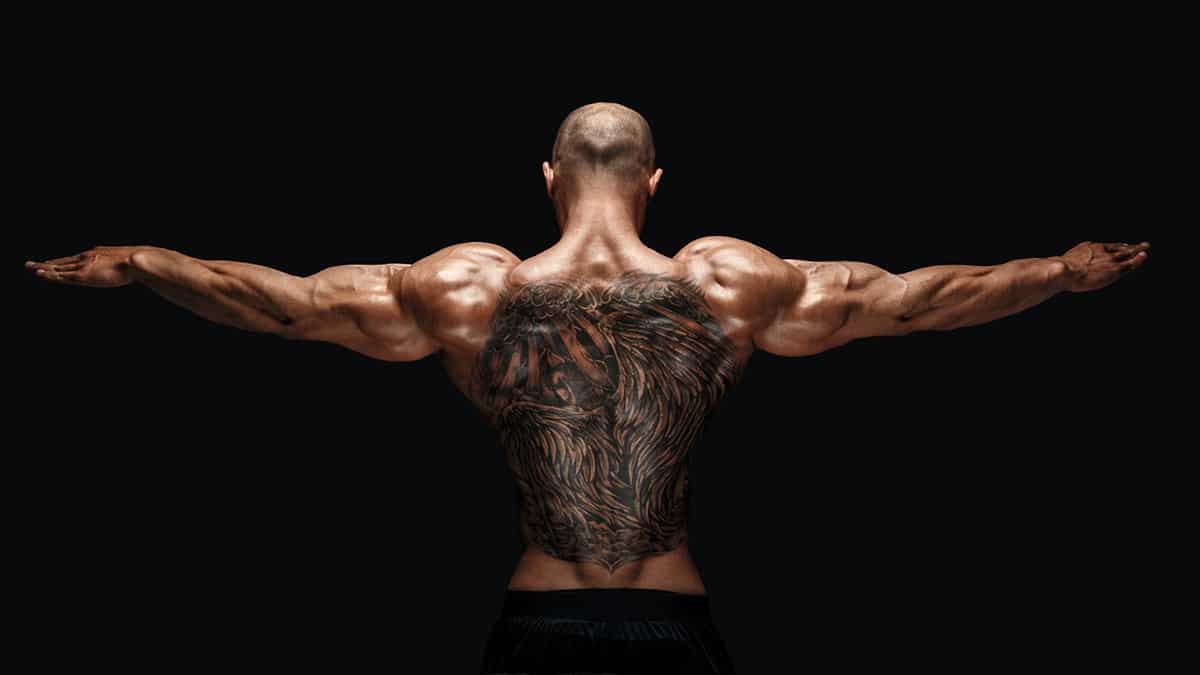Your cart is currently empty!

The 10 Best Ways to Bulk and Broaden Your Shoulders
If there’s one body part that adds an instant air of dominance and masculinity to a man’s physique, it’s the shoulders. They cap off a fit waist (and hopefully the elusive abdominal V), and make your frame look proportional, and, sometimes, even bigger than it is. If you’re not training your shoulder in favour of blasting your…
If there’s one body part that adds an instant air of dominance and masculinity to a man’s physique, it’s the shoulders. They cap off a fit waist (and hopefully the elusive abdominal V), and make your frame look proportional, and, sometimes, even bigger than it is. If you’re not training your shoulder in favour of blasting your bi’s or tri’s, you’re missing out.
If that’s not enough to convince you, maybe this will: when we asked 25 women their opinion on the sexiest body part on a man, shoulders dominated. One woman said: “A large upper body—toned back, shoulders, and arms. I like a man who has the power to lift me up…” But if you don’t care what the ladies think, a strong set of shoulders will make your life easier. Everyday movements like playing sports and lifting stuff overhead will be more of a breeze, plus you’ll reduce your risk for injury during back and chest exercises, and make your workouts less stressful—on your mind and muscles.
We spoke with Noah Bryant, co-author of The Size and Strength Blueprint for the 10 best exercises to thicken and widen your shoulders. “To successfully grow a pair of behemoth shoulders you need to be aware that the deltoid is made up of three ‘heads,’ the anterior deltoid (front), the lateral deltoid (side), and the posterior deltoid (rear),” Bryant says. “For symmetrical growth, you always want to start your training with the big, compound movements, then hit all three heads with lighter isolation movements.”
Pick 2-3 compound movements and 3-4 isolation moves on shoulder day to hone capped shoulders, bulked traps, and a broader upper body that’ll show through your bulkiest winter sweaters.
1. Overhead Shoulder press
*Compound exercise*
“This is one of the best overall delt-developing exercises,” Bryant says. While most guys think of the bench press as the ultimate upper-body exercise, the overhead press truly is a tremendous muscle-builder. If you have a healthy back and shoulders, you don’t make any rookie mistakes, and you execute it with proper form, you’re practically guaranteed to fill out your frame. You also get the added benefit of working your triceps.
How to do it:
-Grasp the bar with a narrow grip that’s a little wider than shoulder-width. (Note: This will vary from person to person.)
-Make sure your elbows are vertical (perpendicular to the ground and not flared out).
-Your feet should be slightly wider than shoulder-width. With the bar resting in front of you on your anterior (front) delts, tighten your legs, glutes, back, and abs, and begin pressing the bar upward.
-You will have to move your head slightly out of the way of the bar on the way up. Once the bar clears your head, you can move your head back to its natural position.
-Fully extend your elbows with the bar directly above the crown of your head. Shrug your shoulders at the top of the movement to engage your traps and prevent injury and pain-related impingement.
-Make sure you’re not doing a push press. Don’t bend your knees and explode up; this will make your legs the prime mover in the start of the lift, rather than your delts.
Do 3-5 sets of 5-8 reps (Note: You might have to go lower in weight than you’re used to in order to get the form right; also because this works smaller, lesser-used muscles in your upper body).
2A. Seated behind-the-neck press
*Isolation exercise*
This is another full-shoulder exercise that can cause injury when executed improperly. But when it’s done right, the seated behind-the-neck press effectively works the entire musculature of your shoulders, Bryant says.
How to do it:
-Start in a seated position on a bench that has back support.
-With your hands facing away from your body (pronated grip), grab the bar a couple inches wider than shoulder-width.
-Push the bar up, extending and straightening your elbows to an overhead position, taking care not to lock them out (this will torch your delts and keep them under tension throughout the reps).
-Lower the barbell behind your head, flexing your neck slightly forward (read: don’t push your head or neck too far). Right before the bar makes contact with your traps and the base of your neck (or before this point if you feel any discomfort), begin pressing the bar back up.
-Extend the bar above your head and immediately begin the next rep.
Do 3-5 sets of 6-10 reps.
2B. Seated alternate (unilateral) dumbbell press
*Compound exercise*
“Doing this exercise unilaterally (one arm at a time) maximizes time under tension and helps to identify and eliminate imbalances,” Bryant says.
How to do it:
-While seated, start with both dumbbells in the locked-out position above your head, palms facing out/forward.
-Slowly lower one arm at a time, then press the dumbbell back up.
-Keep your non-moving hand locked out above your head (until the hand in motion returns to the top), or keep it stationary on your lap.
-Repeat this process using your other arm.
Do 4 sets of 6-8 reps on each arm.
3. Barbell upright row
*Compound exercise*
“Barbell upright rows will hit your front and side deltoids, and it’ll tie in the traps,” Bryant says. Again, take care to execute with proper form.
How to do it:
-Grasp the bar just narrower than shoulder-width apart with an overhand grip.
-Pull the bar straight up toward your chin, keeping it close to your body. “There is no need to go higher than your chin,” Bryant says. “Pulling any higher can aggravate your shoulders and any added benefit is negligible.” (This is where people tend to get hurt.)
-Lower the bar back down and repeat.
Do 4 sets of 8-15 reps.
4. Barbell front raise
*Isolation exercise*
You’re targeting your front delts, but you’ll feel the fatigue setting into your side delts as well. Bryant advises: “Keep the weight light enough to perform the lift with good technique.” Note: You can also use dumbbells or exercise bands if you’re working out at home.
How to do it:
-While standing, position your hands on a barbell about shoulder-width apart. Use an overhand grip so your palms are facing down.
-Stand up straight so the bar is hanging down, resting against your thighs.
-Pull your shoulder blades back and core in, then position the barbell about 5″ from your body. (This is the starting position.)
-Lift the bar in an arc motion, keeping your arms completely straight, and raise the barbell up to shoulder height. “Try not to swing or ‘cheat,’” Bryant says. “Keep these strict so you feel your front delts moving the weight.”
-Pause, then lower the barbell back to the starting p
osition.
Do 4-5 sets of 12-20 reps.
5. Incline lateral raise
*Isolation exercise*
“This is a great isolation movement for your side delts,” Bryant says. “Make sure to emphasize the stretch at the bottom of the lift and keep the reps controlled.”
How to do it:
-Grab a pair of dumbbells and sit on an incline bench with your arms straight down at your sides.
-Raise the dumbbells straight out (so your arms are parallel to the floor) until you reach shoulder level. Then lower your arms, keeping control of the dumbbells the whole time.
Do 3-5 sets of 12-15 reps.
6. Face pull
*Compound exercise*
“Face pulls work the posterior deltoid and, surprisingly to most, even put extreme stress on the medial deltoid,” Bryant says. “Pulls also target your back’s weak scapular muscles, which aid in stabilization of your shoulder joints—great for shoulder health.”
How to do it:
-Use the rope attachment on the highest pulley of a cable weight machine.
-Start with the rope a couple inches above your eyes.
-Grab the rope with an overhand grip, and take a step back so there’s tension in the rope.
-Sit your hips back, and begin pulling the cable. Let your elbows flare out so they’re parallel to the ground.
-Pull the rope toward your eyebrow, then return it—under control—to the starting position.
Do 3-5 sets of 15-20 reps.
7. Bentover lateral shoulder raise
*Isolation exercise*
“The Bentover lateral raise directly targets your posterior delt (the back of the shoulders),” Bryant says. The key here is to keep the movement strict to really get the benefit of the exercise.
How to do it:
-Bend over so your torso is parallel to the ground with dumbbells in each hand. (Note: Keep your lower back in its natural arch; you don’t want a hump back.)
-Let your arms hang straight down to the ground with your palms facing one another.
-Use your rear delts, by squeezing your shoulder blades together, to lift the weights in an arc motion until they’re parallel to the floor. Your thumbs should be pointing to the ceiling.
-Return to the starting position.
Do 3-5 sets of 8-12 reps
8. Incline I,Y,T’s
*Compound exercise*
Unlike some of the other moves, which have an emphasis on bulking your upper body, this movement really hones in on shoulder health, Bryant says. Though it’ll give you the aesthetic you’re looking for, too.
How to do it:
-Lie chest-down on an adjustable bench at a 45° incline with your arms hanging down, and a dumbbell in each hand. (Your toes will be touching the ground.)
-First, while squeezing your shoulder blades together, raise the dumbbells straight out to your side (making the letter “T”). Return them to the hanging position.
-Next, raise the dumbbells to head-level, halfway between your sides and straight in front of you (making the letter “Y”). Return them to the hanging position.
-Last, raise the dumbbells straight out in front of you (making the letter “I”).
This is 1 rep.
Keep the weight very light and do 4 sets of 5-8 reps.
9. Standing side raise + front raise superset
*Isolation exercises*
This is a combination of two exercises. First you’ll do a set of side raises, then immediately go into a set of front raises to complete the superset.
Standing side raise
How to do it:
-Stand with your knees slightly bent, leaning forward with a dumbbell in either hand.
-Raise your upper arms out to your sides until your elbows (which should be slightly bent) are shoulder-height.
-Return to the start position.
Note: Don’t use a weight that’s too heavy; you don’t want to heave the weight or use momentum to complete the motion. Make sure your hands don’t raise up higher than your elbows, either (as that takes the weight off your delts). To really stimulate your side delts, keep a slight bend in your elbows and then raise your upper arms out to your sides rather than out in front of your body. This will ensure you build up overall shoulder thickness.
10. Front raises
Front raise exercises really work flexion by isolating your anterior (front) deltoid.
How to do it:
-While standing with your feet hip-width apart, hold a dumbbell in each hand, palms-down, about 5″ in front of your thighs.
-Raise your arms up in front of you, keeping a slight bend in your elbows.
-Pause when the dumbbells reach shoulder-height, then slowly bring them back to the starting position.
Note: Don’t use momentum or lower the dumbbells too quickly. You want to keep the motion controlled to get a good contraction in your shoulder in order to improve stability through the joint.
Do 3-5 sets of 10 reps of each exercise (for a total of 20 reps per set).




